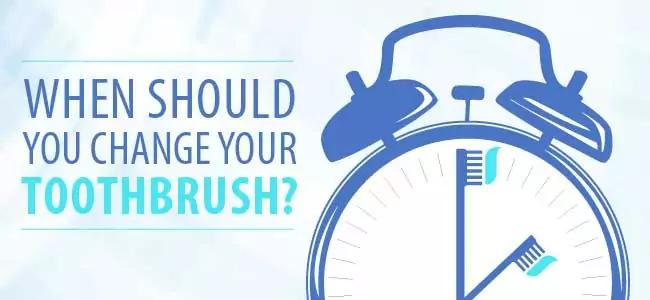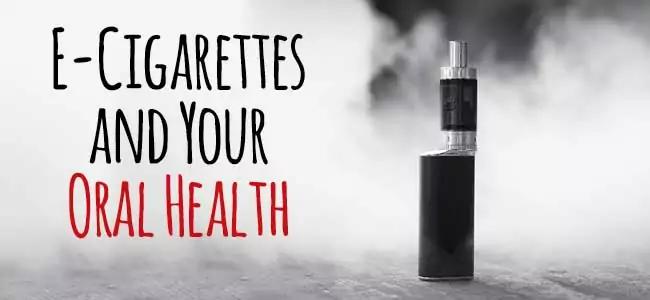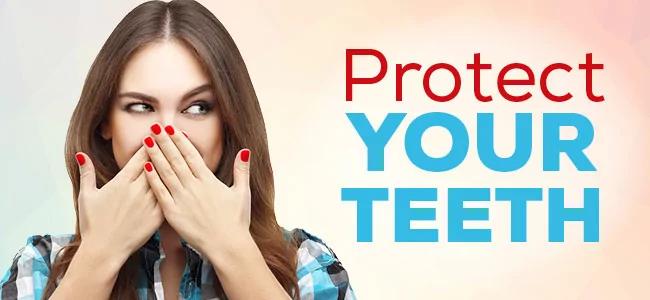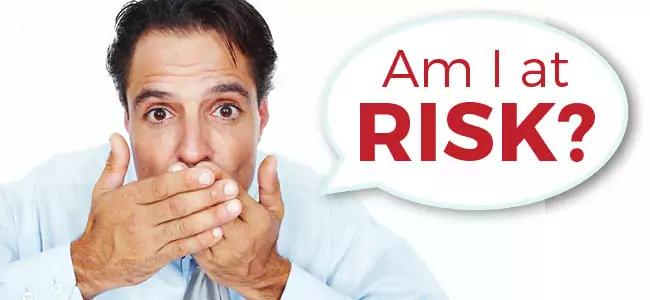When Should You Change Your Toothbrush?

Keep Your Toothbrush in Fighting Shape
Everything You Need to Know About Your Toothbrush
You hear it time and time again: Brush your teeth at least twice a day. It becomes so routine that you brush your teeth while juggling a few other tasks at the same time. How much time goes by before you notice the shape your toothbrush is in? Have you ever thought to yourself, “I don’t need to clean my toothbrush, my toothbrush cleans me!” The condition of your toothbrush is often the last thing you think about in your busy life, but it plays a significant factor in your oral health.
Symptoms of an Unclean, Older Toothbrush
The most common issue with an older toothbrush is effectiveness. When the bristles are frayed, its cleaning ability is compromised — leaving your teeth more exposed to bacteria.
According to theAmerican Dental Association (ADA), you should monitor and replace your toothbrush more often if you or a family member have:
- A systemic disease that may be transmissible by blood or saliva
- A compromised immune system or low resistance to infection due to disease, chemotherapy, radiation treatment, etc.
How to Disinfect Your Toothbrush
- Rinse and air dry. The simplest way to keep your toothbrush clean: After every use, rinse it and keep it upright in an open area.
- Soak it in hydrogen peroxide.
- Boil it in hot water. This is another simple option, but be sure the toothbrush is completely cooled before handling/using. No one wants scalded gums.
- Use an ultra-violet light toothbrush sanitizer. These sanitizers made for toothbrushes (more specifically, electric toothbrush heads) are a good option, but studies show that while they do kill bacteria, they don’t have a distinct advantage over any other method.
The ADA warns to be wary of any product that says it will do more than sanitize or reduce bacterial contamination. If you are interested in a toothbrush sanitation product, make sure it isFood and Drug Administration approved. There isn’t an obvious answer as to which method is preferred or best, so do what works for you.
Not Recommended Toothbrush Care
- Microwave: While this idea makes sense on paper, the ADA doesn’t approve. It will most likely kill bacteria on your toothbrush, but zapping it can have adverse effects on the brush itself.
- Dishwasher: While this is an effective way to clean your toothbrush, the ADA states that this method will also compromise the quality of your brush.
How Often Should I Change My Toothbrush?
For typical usage with no special circumstances, you should change your toothbrush every three to four months. If you see that your toothbrush bristles are frayed or beginning to fray, replace it. If your toothbrush seems to fray too fast, you are mostly likely brushing too hard — go easy on those teeth!
Do I Need to Change My Toothbrush After I’ve Been Sick?
Research shows that this is unnecessary. While those germs are still on your toothbrush, your body has the antibodies to fight off anything related to that particular sickness you just got over. With this in mind, don’t share said toothbrush (or any toothbrush, for that matter) with another person, because they can get sick from those germs.
To keep your teeth strong and your mouth healthy, the quality of your toothbrush absolutely matters. It is important to keep your brush as clean as possible while you are using it. The most beneficial thing you can do is keep track of how long you have been using your toothbrush and replace it routinely. For more information, contact your Hot Springs, AR dentist Dr. Lance Porter’s office today.
E-Cigarettes and Your Oral Health: The Smokeless Threat to Your Smile

Keep Your Toothbrush in Fighting Shape
Everything You Need to Know About Your Toothbrush
You hear it time and time again: Brush your teeth at least twice a day. It becomes so routine that you brush your teeth while juggling a few other tasks at the same time. How much time goes by before you notice the shape your toothbrush is in? Have you ever thought to yourself, “I don’t need to clean my toothbrush, my toothbrush cleans me!” The condition of your toothbrush is often the last thing you think about in your busy life, but it plays a significant factor in your oral health.
Symptoms of an Unclean, Older Toothbrush
The most common issue with an older toothbrush is effectiveness. When the bristles are frayed, its cleaning ability is compromised — leaving your teeth more exposed to bacteria.
According to theAmerican Dental Association (ADA), you should monitor and replace your toothbrush more often if you or a family member have:
- A systemic disease that may be transmissible by blood or saliva
- A compromised immune system or low resistance to infection due to disease, chemotherapy, radiation treatment, etc.
How to Disinfect Your Toothbrush
- Rinse and air dry. The simplest way to keep your toothbrush clean: After every use, rinse it and keep it upright in an open area.
- Soak it in hydrogen peroxide.
- Boil it in hot water. This is another simple option, but be sure the toothbrush is completely cooled before handling/using. No one wants scalded gums.
- Use an ultra-violet light toothbrush sanitizer. These sanitizers made for toothbrushes (more specifically, electric toothbrush heads) are a good option, but studies show that while they do kill bacteria, they don’t have a distinct advantage over any other method.
The ADA warns to be wary of any product that says it will do more than sanitize or reduce bacterial contamination. If you are interested in a toothbrush sanitation product, make sure it isFood and Drug Administration approved. There isn’t an obvious answer as to which method is preferred or best, so do what works for you.
Not Recommended Toothbrush Care
- Microwave: While this idea makes sense on paper, the ADA doesn’t approve. It will most likely kill bacteria on your toothbrush, but zapping it can have adverse effects on the brush itself.
- Dishwasher: While this is an effective way to clean your toothbrush, the ADA states that this method will also compromise the quality of your brush.
How Often Should I Change My Toothbrush?
For typical usage with no special circumstances, you should change your toothbrush every three to four months. If you see that your toothbrush bristles are frayed or beginning to fray, replace it. If your toothbrush seems to fray too fast, you are mostly likely brushing too hard — go easy on those teeth!
Do I Need to Change My Toothbrush After I’ve Been Sick?
Research shows that this is unnecessary. While those germs are still on your toothbrush, your body has the antibodies to fight off anything related to that particular sickness you just got over. With this in mind, don’t share said toothbrush (or any toothbrush, for that matter) with another person, because they can get sick from those germs.
To keep your teeth strong and your mouth healthy, the quality of your toothbrush absolutely matters. It is important to keep your brush as clean as possible while you are using it. The most beneficial thing you can do is keep track of how long you have been using your toothbrush and replace it routinely. For more information, contact your Hot Springs, AR dentist Dr. Lance Porter’s office today.
Protect Your Teeth: Preventive Steps Toward Better Oral Health

Keep Your Toothbrush in Fighting Shape
Everything You Need to Know About Your Toothbrush
You hear it time and time again: Brush your teeth at least twice a day. It becomes so routine that you brush your teeth while juggling a few other tasks at the same time. How much time goes by before you notice the shape your toothbrush is in? Have you ever thought to yourself, “I don’t need to clean my toothbrush, my toothbrush cleans me!” The condition of your toothbrush is often the last thing you think about in your busy life, but it plays a significant factor in your oral health.
Symptoms of an Unclean, Older Toothbrush
The most common issue with an older toothbrush is effectiveness. When the bristles are frayed, its cleaning ability is compromised — leaving your teeth more exposed to bacteria.
According to theAmerican Dental Association (ADA), you should monitor and replace your toothbrush more often if you or a family member have:
- A systemic disease that may be transmissible by blood or saliva
- A compromised immune system or low resistance to infection due to disease, chemotherapy, radiation treatment, etc.
How to Disinfect Your Toothbrush
- Rinse and air dry. The simplest way to keep your toothbrush clean: After every use, rinse it and keep it upright in an open area.
- Soak it in hydrogen peroxide.
- Boil it in hot water. This is another simple option, but be sure the toothbrush is completely cooled before handling/using. No one wants scalded gums.
- Use an ultra-violet light toothbrush sanitizer. These sanitizers made for toothbrushes (more specifically, electric toothbrush heads) are a good option, but studies show that while they do kill bacteria, they don’t have a distinct advantage over any other method.
The ADA warns to be wary of any product that says it will do more than sanitize or reduce bacterial contamination. If you are interested in a toothbrush sanitation product, make sure it isFood and Drug Administration approved. There isn’t an obvious answer as to which method is preferred or best, so do what works for you.
Not Recommended Toothbrush Care
- Microwave: While this idea makes sense on paper, the ADA doesn’t approve. It will most likely kill bacteria on your toothbrush, but zapping it can have adverse effects on the brush itself.
- Dishwasher: While this is an effective way to clean your toothbrush, the ADA states that this method will also compromise the quality of your brush.
How Often Should I Change My Toothbrush?
For typical usage with no special circumstances, you should change your toothbrush every three to four months. If you see that your toothbrush bristles are frayed or beginning to fray, replace it. If your toothbrush seems to fray too fast, you are mostly likely brushing too hard — go easy on those teeth!
Do I Need to Change My Toothbrush After I’ve Been Sick?
Research shows that this is unnecessary. While those germs are still on your toothbrush, your body has the antibodies to fight off anything related to that particular sickness you just got over. With this in mind, don’t share said toothbrush (or any toothbrush, for that matter) with another person, because they can get sick from those germs.
To keep your teeth strong and your mouth healthy, the quality of your toothbrush absolutely matters. It is important to keep your brush as clean as possible while you are using it. The most beneficial thing you can do is keep track of how long you have been using your toothbrush and replace it routinely. For more information, contact your Hot Springs, AR dentist Dr. Lance Porter’s office today.
Summer is Here! Are your Lips Ready?

Keep Your Toothbrush in Fighting Shape
Everything You Need to Know About Your Toothbrush
You hear it time and time again: Brush your teeth at least twice a day. It becomes so routine that you brush your teeth while juggling a few other tasks at the same time. How much time goes by before you notice the shape your toothbrush is in? Have you ever thought to yourself, “I don’t need to clean my toothbrush, my toothbrush cleans me!” The condition of your toothbrush is often the last thing you think about in your busy life, but it plays a significant factor in your oral health.
Symptoms of an Unclean, Older Toothbrush
The most common issue with an older toothbrush is effectiveness. When the bristles are frayed, its cleaning ability is compromised — leaving your teeth more exposed to bacteria.
According to theAmerican Dental Association (ADA), you should monitor and replace your toothbrush more often if you or a family member have:
- A systemic disease that may be transmissible by blood or saliva
- A compromised immune system or low resistance to infection due to disease, chemotherapy, radiation treatment, etc.
How to Disinfect Your Toothbrush
- Rinse and air dry. The simplest way to keep your toothbrush clean: After every use, rinse it and keep it upright in an open area.
- Soak it in hydrogen peroxide.
- Boil it in hot water. This is another simple option, but be sure the toothbrush is completely cooled before handling/using. No one wants scalded gums.
- Use an ultra-violet light toothbrush sanitizer. These sanitizers made for toothbrushes (more specifically, electric toothbrush heads) are a good option, but studies show that while they do kill bacteria, they don’t have a distinct advantage over any other method.
The ADA warns to be wary of any product that says it will do more than sanitize or reduce bacterial contamination. If you are interested in a toothbrush sanitation product, make sure it isFood and Drug Administration approved. There isn’t an obvious answer as to which method is preferred or best, so do what works for you.
Not Recommended Toothbrush Care
- Microwave: While this idea makes sense on paper, the ADA doesn’t approve. It will most likely kill bacteria on your toothbrush, but zapping it can have adverse effects on the brush itself.
- Dishwasher: While this is an effective way to clean your toothbrush, the ADA states that this method will also compromise the quality of your brush.
How Often Should I Change My Toothbrush?
For typical usage with no special circumstances, you should change your toothbrush every three to four months. If you see that your toothbrush bristles are frayed or beginning to fray, replace it. If your toothbrush seems to fray too fast, you are mostly likely brushing too hard — go easy on those teeth!
Do I Need to Change My Toothbrush After I’ve Been Sick?
Research shows that this is unnecessary. While those germs are still on your toothbrush, your body has the antibodies to fight off anything related to that particular sickness you just got over. With this in mind, don’t share said toothbrush (or any toothbrush, for that matter) with another person, because they can get sick from those germs.
To keep your teeth strong and your mouth healthy, the quality of your toothbrush absolutely matters. It is important to keep your brush as clean as possible while you are using it. The most beneficial thing you can do is keep track of how long you have been using your toothbrush and replace it routinely. For more information, contact your Hot Springs, AR dentist Dr. Lance Porter’s office today.
Am I at Risk? The Question That’s on Everyone’s Lips

Keep Your Toothbrush in Fighting Shape
Everything You Need to Know About Your Toothbrush
You hear it time and time again: Brush your teeth at least twice a day. It becomes so routine that you brush your teeth while juggling a few other tasks at the same time. How much time goes by before you notice the shape your toothbrush is in? Have you ever thought to yourself, “I don’t need to clean my toothbrush, my toothbrush cleans me!” The condition of your toothbrush is often the last thing you think about in your busy life, but it plays a significant factor in your oral health.
Symptoms of an Unclean, Older Toothbrush
The most common issue with an older toothbrush is effectiveness. When the bristles are frayed, its cleaning ability is compromised — leaving your teeth more exposed to bacteria.
According to theAmerican Dental Association (ADA), you should monitor and replace your toothbrush more often if you or a family member have:
- A systemic disease that may be transmissible by blood or saliva
- A compromised immune system or low resistance to infection due to disease, chemotherapy, radiation treatment, etc.
How to Disinfect Your Toothbrush
- Rinse and air dry. The simplest way to keep your toothbrush clean: After every use, rinse it and keep it upright in an open area.
- Soak it in hydrogen peroxide.
- Boil it in hot water. This is another simple option, but be sure the toothbrush is completely cooled before handling/using. No one wants scalded gums.
- Use an ultra-violet light toothbrush sanitizer. These sanitizers made for toothbrushes (more specifically, electric toothbrush heads) are a good option, but studies show that while they do kill bacteria, they don’t have a distinct advantage over any other method.
The ADA warns to be wary of any product that says it will do more than sanitize or reduce bacterial contamination. If you are interested in a toothbrush sanitation product, make sure it isFood and Drug Administration approved. There isn’t an obvious answer as to which method is preferred or best, so do what works for you.
Not Recommended Toothbrush Care
- Microwave: While this idea makes sense on paper, the ADA doesn’t approve. It will most likely kill bacteria on your toothbrush, but zapping it can have adverse effects on the brush itself.
- Dishwasher: While this is an effective way to clean your toothbrush, the ADA states that this method will also compromise the quality of your brush.
How Often Should I Change My Toothbrush?
For typical usage with no special circumstances, you should change your toothbrush every three to four months. If you see that your toothbrush bristles are frayed or beginning to fray, replace it. If your toothbrush seems to fray too fast, you are mostly likely brushing too hard — go easy on those teeth!
Do I Need to Change My Toothbrush After I’ve Been Sick?
Research shows that this is unnecessary. While those germs are still on your toothbrush, your body has the antibodies to fight off anything related to that particular sickness you just got over. With this in mind, don’t share said toothbrush (or any toothbrush, for that matter) with another person, because they can get sick from those germs.
To keep your teeth strong and your mouth healthy, the quality of your toothbrush absolutely matters. It is important to keep your brush as clean as possible while you are using it. The most beneficial thing you can do is keep track of how long you have been using your toothbrush and replace it routinely. For more information, contact your Hot Springs, AR dentist Dr. Lance Porter’s office today.
Schedule a Dental Consultation
Dr. Porter and Dr. Will, along with their team are are highly qualified and trusted in this community. With over 200 5-star reviews online, our competence and credibility can’t be doubted. So don’t wait to call. Make an appointment today!
Contact Us Today
1919 Malvern Avenue
Hot Springs, AR 71901
- Monday 7:00 am - 3:00 pm
- Tuesday 7:00 am - 3:00 pm
- Wednesday 7:00 am - 4:00 pm
- (lunch 12-1pm)
- Thursday 7:00 am - 3:00 pm
- Friday 8:00 am - 1:00 pm
- (may vary in the Summer)
- Saturday Closed
- Sunday Closed